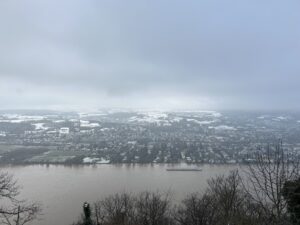Bonn and the Rhine

While in Bonn I have had many chances to catch a glimpse of the Rhine: passing it on a run, seeing it outside the bus window, or looking at its bends on google maps. Countless bridges span bank to bank and cargo ships are a common occurrence on the river. There is now plenty of infrastructure which is built around the Rhine to leverage it for our human needs. Transportation and water management are two huge parts of the infrastructure I have observed on the Rhine.
Rivers have always been a source of interest for me. The way that over millions of years a small stream of water can cut through rock and change the topography of a region is astounding. Rivers have also impacted the settlement of humans across the world. Historically they have been passageways for knowledge, goods, and people. The Rhine is no different. I recently learned about how Bonn and Köln were ancient Roman colonies. The river played a large role in the establishment of these settlements. Julius Caesar famously crossed the Rhine which led to his victory in the region during the Gallic War (Julius Caesar: Building Bridges, 2023). The Rhine in that case was an obstacle and a strategic feature which served as protection for civilizations nearby. In fact during world war ll the river served as a barrier to the allied forces (Rhine River Facts, n.d.). Just as the river kept people out it also served as an avenue for cultural development. There are five UNESCO world heritage sites as well as at least nine major cities along its banks (Rhine River Facts, n.d.). The Rhine has been a crucial part of the history of Europe. It is a great example of the power of a river.
The first weekend of this trip I was invited to go on a hike with a friend and their host family. We were planning to cross the Rhine to the “Dragon Rock” castle ruins. On this adventure we were going to use a ferry to go across on foot, however, the high water level made this impossible as the dock was flooded. This added over two hours of travel time to our journey.

Being located on a river, Bonn has both the advantage of easier travel and trade but also has to manage varying water levels. When flooding occurs and water levels rise the room overhead for ships to be able to cross underneath bridges becomes too small, therefore blocking trade and transportation. High water levels can also disrupt ports and docks which happened in our case. Due to the complex nature of managing the river infrastructure with so many varying factors the Central Commission was created to oversee it (Organization, n.d.). This organization controls regulations on the Rhine as well as sharing and collecting information about the river. The picture above shows a water level reader which displays the current water level of the Rhine in Köln. The safety of people who live in the Rhine’s flooding zones as well as people who depend on transportation across the river rely on organizations like this one. Infrastructure in Bonn is heavily intertwined with the Rhine river which makes it an important factor in its development.
Written by Maya Maynard
References
Julius Caesar: Building Bridges. (2023, March). Karwansaray Publishers. Retrieved January 20, 2025, from https://www.karwansaraypublishers.com/blogs/ancient-warfare-blog/julius-caesar-building-bridges?srsltid=AfmBOoo0vQwN0SAJmjreBbmbWEFedGXsM6XM24SNx3MCXVa-1QJ-3ott
Organization. (n.d.). Central Commission for the Navigation of the Rhine. Retrieved January 20, 2025, from https://www.ccr-zkr.org/
Rhine River Facts. (n.d.). Tauck. Retrieved January 20, 2025, from https://www.tauck.co.uk/river-cruises/european-river-facts/rhine-river-facts
